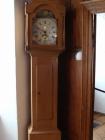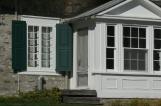17
The parishioners had blind faith in their priest's abilities. Accordingly, his prestigious position led him to be the focal point of parochial life. No decisions were taken without his approval and no actions undertaken without his advice.
18
The village priest20th century, circa 1995
Lotbinière (Quebec), Canada
 Credits:
Credits:Folklore and ethnology archives at Laval University, Coll. Luc Lacourcière, recording no. 2772.
19
The priest equally commanded respect by his education, which was clearly superior to the education of the parishioners. This gap was readily apparent in the use of Latin during the liturgical ceremonies. This served as a means to preserve the aura of mystery surrounding the religious rituals.
The uttermost respect was due to the priest and the parishioners had to watch their words, actions and manners in his presence. They had to yield dignity and public recognition to the priest since he was the religious leader of the parish. The parish priest could correct parishioners and advise them of their errors. They had to listen to his counsel and take it into consideration when correcting the aspects of their behavior reprimanded by the priest.
Respect and obedience to the priest's authority was essential to the spiritual well-being of all parishioners. However, as it is the case with all authority figures, the priest could also become the target of raging criticism. Indeed, a fair number of folk songs of the period are less than flattering towards priest characters. The songs feature priests full of the bad habits they usually chastised : impurity, drinking, cupidity, libidinous conduct, etc.
20
The priest's cassock20th century, circa 1976
Cap-Chat, Gaspésie (Quebec), Canada
 Credits:
Credits:Folklore and ethnology archives at Laval University, Coll. Luc Lacourcière, recording no. 3459
21
A DIFFERENT WAY OF LIFE
The parish priest gained a certain prestige from his professional status. His way of life resembled that of the other village notables and his home reflected this comfortable lifestyle.
For Wenceslas Fréchette, the value of money, as well as power and grandeur, had their importance. In 1855, he had the front porch of the presbytery built at his own expense. The new neoclassical style entryway gave a noble appearance and an updated look to the front of the building.
23
It wasn't only the dimensions or the look of the building that distinguished the presbytery from other houses. The furniture also attested to a different way of life.
24
Commode19th century, circa 1800
Batiscan (Quebec), Canada
 Credits:
Credits:Réjeanne Bourret-Bouchard private collection
Archives of the Fondation des Amis du Vieux presbytère de Batiscan
25
Clock19th century, after 1829
Batiscan (Quebec), Canada
 Credits:
Credits:Collection of the Musée de la civilisation
Archives of the Fondation des Amis du Vieux presbytère de Batiscan
26
Clock19th century, after 1829
Batiscan (Quebec), Canada
 Credits:
Credits:Collection of the Musée de la civilisation
Archives of the Fondation des Amis du Vieux presbytère de Batiscan
27
Clock movement19th century, after 1829
Batiscan (Quebec), Canada
 Credits:
Credits:Collection of the Musée de la civilisation
Archives of the Fondation des Amis du Vieux presbytère de Batiscan
28
Clock movement19th century, after 1829
Batiscan (Quebec), Canada
 Credits:
Credits:Collection of the Musée de la civilisation
Archives of the Fondation des Amis du Vieux presbytère de Batiscan
29
Clergymen's luxurious lifestyles sparked many heated discussions, especially if one weighed it up against the miserable conditions many parishioners faced. The use of the tithe, the fee payed by each parishioner to the church, caused concern to the congregation. It was a general source of discontent within the community since the sums accumulated were used to embellish the church and the presbytery, rather than to offer better services to the population. When strangers came to town and saw such a remarkable building, they had to come to the conclusion that the parish was thriving.
30
The parish priest and the vicars20th century, circa 1972
St. Séverin Beauce (Quebec), Canada
 Credits:
Credits:Folklore and ethnology archives at Laval University, Coll. Marc Gagné, recording no. 673.
